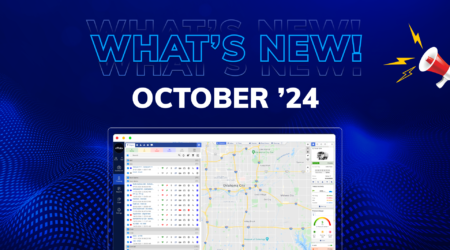How Fleet Monitoring System Can Reduce Operating Costs
In today’s fast-paced business environment, managing a fleet of vehicles efficiently is crucial for any organization involved in logistics, transportation, or field services. Fleet Monitoring Systems, often referred to as fleet telematics systems, have emerged as indispensable tools to streamline operations, enhance safety, and reduce operating costs. In this article, we will delve into the world of Fleet Monitoring Systems, their importance, what users should look for in a system, the advantages they offer, and address some frequently asked questions.
What is a Fleet Monitoring System?
A Fleet Monitoring System, also known as a Fleet Telematics System, is a comprehensive technology solution that enables organizations to monitor and manage their fleet of vehicles in real time. It involves the integration of various hardware and software components that collect data from vehicles and present it to users in a user-friendly format. This data typically includes vehicle location, speed, fuel consumption, maintenance needs, and driver behavior, among other things.
Why it is Needed?
Improved Fleet Efficiency
One of the primary reasons for adopting an FMS is to enhance fleet efficiency. With real-time tracking and monitoring capabilities, businesses can optimize routes, reduce idle time, and eliminate unauthorized vehicle use. This results in reduced fuel consumption, lower maintenance costs, and increased productivity.
Enhanced Safety
Safety on the road is a paramount concern for any fleet manager. An FMS offers features such as driver behavior monitoring, speed tracking, and real-time alerts for harsh driving events. These functionalities promote safe driving practices, reduce accidents, and protect both drivers and company assets.
Cost Reduction
Fleet management can be costly without the right tools in place. An FMS helps in cost reduction by optimizing routes to minimize fuel expenses and reduce vehicle wear and tear. Maintenance schedules can also be efficiently managed, preventing breakdowns and costly repairs.
Asset Protection
Your fleet of vehicles is a valuable asset, and protecting it is crucial. With a fleet monitoring system, you can track the location of each vehicle in real-time. In the unfortunate event of theft, you can quickly recover the stolen vehicle, minimizing losses and potential insurance claims.
Compliance and Reporting
Compliance with industry regulations and reporting requirements is a necessary part of fleet management. FMS software automates record-keeping tasks, ensuring that you always have accurate data on hand for audits and reporting. This reduces administrative burdens and helps avoid penalties for non-compliance.
Customer Satisfaction
For businesses involved in logistics and delivery, customer satisfaction is a top priority. An FMS allows you to provide accurate delivery ETAs and real-time tracking information to customers. This transparency builds trust and enhances customer satisfaction, leading to repeat business and positive reviews.
Environmental Impact
Reducing your fleet’s carbon footprint is not only socially responsible but can also have financial benefits. Fleet monitoring systems enable you to track fuel consumption and emissions, making it easier to implement eco-friendly practices and reduce environmental impact.
What Users Should Look for in a Fleet Monitoring System
User-Friendly Interface:
One of the most important aspects of a fleet monitoring system is its user interface. A user-friendly dashboard and navigation system are essential for ease of use. Look for a system that provides intuitive, simple, and clear displays. This ensures that both seasoned professionals and newcomers to fleet management can easily access and utilize the system’s features.
Real-Time Tracking:
Real-time tracking is a fundamental feature of any fleet monitoring system. Users should prioritize systems that offer accurate, up-to-the-minute location data for all vehicles in the fleet. Real-time tracking helps improve safety, enhance efficiency, and respond promptly to unexpected situations like traffic jams or emergencies.
Geofencing Capabilities:
Geofencing is a powerful tool for fleet managers. It allows you to define specific geographic boundaries and receive notifications when a vehicle enters or exits these areas. This feature can be used for security, compliance, and improving operational efficiency.
Vehicle Health Monitoring:
A reliable fleet monitoring system should not only track the location of vehicles but also provide insights into vehicle health and performance. Look for systems that offer diagnostics, maintenance alerts, and reports on engine performance. This proactive approach helps prevent breakdowns and reduces maintenance costs.
Fuel Monitoring:
Fuel costs are a significant part of a fleet’s operating expenses. A good fleet monitoring system should offer fuel monitoring features, including real-time fuel consumption tracking and alerts for unusual fuel usage patterns. This helps in detecting fuel theft, reducing fuel wastage, and optimizing routes for better fuel efficiency.
Driver Behavior Analysis:
Driver behavior plays a crucial role in fleet safety and cost management. Choose a system that provides driver behavior analysis tools such as speed monitoring, harsh acceleration and braking detection, and idle time tracking. These features help in coaching drivers for safer and more efficient driving practices.
Comprehensive Reporting:
Effective decision-making relies on data analysis. A fleet monitoring system should offer a variety of customizable reports, including historical data, trip summaries, maintenance reports, and compliance reports. Access to detailed information empowers fleet managers to make informed decisions and continuously improve operations.
Integration and Scalability:
Consider the compatibility of the fleet monitoring system with your existing software and hardware. Look for systems that offer easy integration with other fleet management tools, such as maintenance management software or route planning software. Additionally, ensure that the system can scale with your business as it grows.
Alerts and Notifications:
Timely notifications are crucial to addressing issues promptly. Look for a system that can send alerts and notifications via email, SMS, or mobile apps. Customizable alerts for various events, such as maintenance due dates or safety violations, help fleet managers stay on top of critical situations.
The Advantages of a Fleet Monitoring System
Cost Reduction: Fleet Monitoring Systems can significantly reduce operating costs by optimizing routes, reducing fuel consumption, and preventing breakdowns.
Increased Productivity: Real-time tracking and data analysis help organizations improve productivity by minimizing downtime and maximizing asset utilization.
Enhanced Safety: Monitoring driver behavior promotes safer driving practices and reduces the risk of accidents.
Regulatory Compliance: These systems help organizations stay compliant with industry regulations and avoid penalties.
Improved Customer Service: Accurate tracking and on-time deliveries lead to improved customer satisfaction.
Frequently Asked Questions (FAQ)
Q1: How do Fleet Monitoring Systems improve fuel efficiency?
A1: Fleet Monitoring Systems monitor vehicle speed, idle time, and fuel consumption, allowing organizations to identify fuel-wasting habits and take corrective action, ultimately reducing fuel costs.
Q2: Can a Fleet Monitoring System help prevent vehicle theft?
A2: Yes, Fleet Monitoring Systems can help prevent vehicle theft by providing real-time tracking and anti-theft features such as remote engine immobilization.
Q3: Are Fleet Monitoring Systems suitable for small businesses?
A3: Yes, Fleet Monitoring Systems can benefit businesses of all sizes. They can be tailored to meet the specific needs and budget of small businesses.
Q4: What is the typical ROI (Return on Investment) for implementing a Fleet Monitoring System?
A4: The ROI of a Fleet Monitoring System varies depending on factors such as fleet size, industry, and usage. However, many organizations experience a positive ROI within a year or less due to reduced operating costs.
Conclusion
In today’s competitive business landscape, Fleet Monitoring Systems are no longer a luxury but a necessity for organizations with fleets of vehicles. These systems play a pivotal role in reducing operating costs, enhancing efficiency, and improving overall fleet management. By choosing the right system and harnessing its capabilities, businesses can experience significant cost savings while maintaining a competitive edge in their respective industries.





